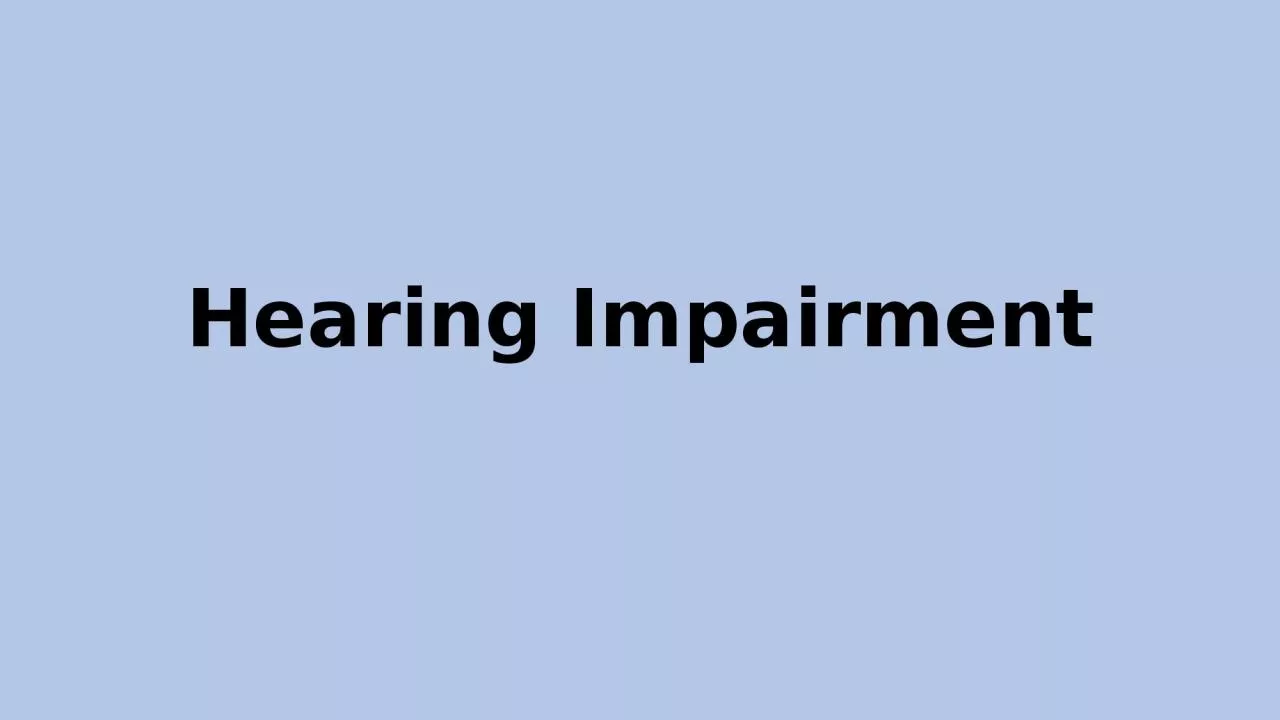

IDEA Definition 3008 c 5 Hearing impairment means an impairment in hearing whether permanent or fluctuating that adversely affects a childs educational performance but that is not included under the definition of deafness in this section ID: 1044675
Download Presentation The PPT/PDF document "Hearing Impairment Definition" is the property of its rightful owner. Permission is granted to download and print the materials on this web site for personal, non-commercial use only, and to display it on your personal computer provided you do not modify the materials and that you retain all copyright notices contained in the materials. By downloading content from our website, you accept the terms of this agreement.
1. Hearing Impairment
2. DefinitionIDEA Definition § 300.8 (c) (5)Hearing impairment means an impairment in hearing, whether permanent or fluctuating, that adversely affects a child’s educational performance but that is not included under the definition of deafness in this section.
3. Eligibility CriteriaDeafness and Hearing Impairment are clinical terms as well as separate educational disability classifications, under the IDEA. The eligibility criteria for both Deafness and Hearing Impairment requires documentation of an adverse educational impact and the need forspecially designed instruction, which is not based solely on a clinical or medical diagnosis.The terms “deaf or hard of hearing” and “hearing loss” are now utilized to replace the term “hearing impaired and its variations.” The term “hard of hearing” may also be used in place of “hearing impairment” for the eligibility determination.
4. Professional Advocacy OrganizationsVDOE Deaf and Hard of Hearing – VDOE lists a wide range of organizations for supporting children, youth, and adults who are deaf or hard of hearing based on communication preferences.
5. PrevalenceIn 2020–21, the number of students ages 3–21 who received special education services under the Individuals with Disabilities Education Act (IDEA) was 7.2 million, or 15 percent of all public school students. .5% of all school-age children in special education, ages 3 through 21 years, received special education under the category of HI .
6. CausesConductive hearing loss can be the result of:ear infectionsallergiesswimmer’s eara buildup of wax in the earA foreign object that has become stuck in the ear, benign tumors or scarring of the ear canal due to recurrent infections are all potential causes of hearing loss.Sensorineural Hearing Loss (SNHL)SNHL happens when there’s damage to inner ear structures or in the nerve pathways to the brain. This type of hearing loss is usually permanent. SNHL makes even distinct, normal, or loud sounds seem muffled or unclear.
7. Causes part 2SNHL can result from:birth defects that alter the structure of the earagingworking around loud noisestrauma to the head or skullMeniere’s disease, which is a disorder of the inner ear that can affect hearing and balance.acoustic neuroma, which is a noncancerous tumor that grows on the nerve that connects the ear to the brain called the “vestibular cochlear nerve”InfectionsInfections such as the following can also damage the nerves of the ear and lead to SNHL:measlesmeningitismumpsscarlet fever
8. Causes part 3Ototoxic MedicationsSome medications, called ototoxic medications, may also cause SNHL. According to the ASHA, there are over 200 over-the-counter and prescription medications that may cause hearing loss. If you’re taking medications for cancer, heart disease, or a serious infection, talk to your doctor about the hearing risks involved with each.Mixed Hearing LossMixed hearing loss may also occur. This happens when both conductive hearing loss and SNHL occur at the same time.
9. CharacteristicsSpeech DelaysCommunication DifficultiesSelective HearingBehavioral CharacteristicsDifferential Diagnosis
10. Instructional StrategiesLet the child see the book, your face and signs simultaneously.Don’t be limited by the print - expand on pictures.Be dramatic - use props, exaggerate, use facial expression, eye gaze, body shift to show different characters.Vary location of signing - on book, on child, etc.Read a story several times if a child asks.Act out the story together after reading it.Utilize the whole language philosophy.Use signed English, Cued Speech, and more fingerspelling to clarify differences between ASL and printed English.Encourage students to translate between sign language and English, and to make connections between all modes presented.
11. PlacementsThe majority of children who are deaf or hard of hearing attend local public schools63% receive most of their education in regular education classrooms with hearing students15% attend resource rooms for part of the school day11% are served in separate classrooms2% attend residential schools for the deafAbout 50% of all students with hearing loss go on to college.